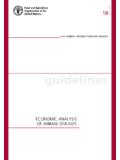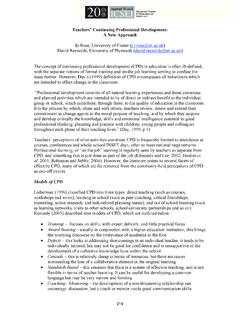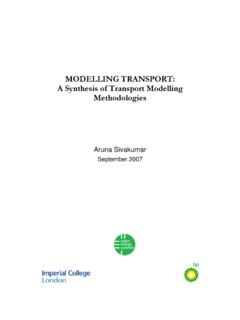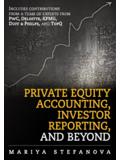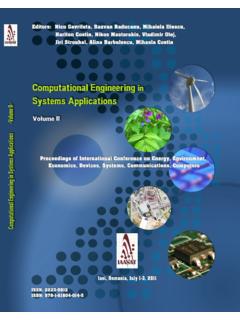Transcription of Is it possible to benchmark private equity …
1 LP 2004 The problems start with the fundamental differences betweenprivate equity and other publicly-traded asset classes. JesseReyes, vice president at Venture Economics, which, among others,works with the National Venture Capital Association in the US andthe European Venture Capital Association in Brussels to produceperformance figures for their members, outlines the control issue. In the public markets the money that an investment manager getsis not under his control and you do not want to penalise or rewardfor a timing decision that is not under his control.
2 Since privateequity investment timing is totally under the manager s control,timing decisions should be part of the performance measure so hecan be penalised or rewarded for these timing decisions, he says. Unfortunately many managers faced with selecting andmonitoring a portfolio of investments in private equity funds aretasked to do so within organisations that promote a return figurederived from a benchmark or index that ignores timing, when infact the very way private equity funds and their managers workout their relative success is based on a calculation, called theInternal Rate of Return (IRR), that is wholly dependent on timing.
3 private equity has traditionally used IRR whereas publicmarkets use time weighted returns. Time weighted return makes an assumption that no transaction has happened duringthe investment period. If a VC put money in one day and took itout five years later the IRR would be the same as time weightedreturn, other things being equal, says Reyes. This point is clearly demonstrated in figure 1, provided byCapital Dynamics, which note that in Case A, the 100 unitsinvested achieved a 0% return during the first year. After year199 of those 100 are withdrawn, leaving only one unit, whichgoes on to achieve a 20% return in year two.
4 The net result is thatthe IRR for the two year period is just , whereas for thetime weighted return calculation it is 10%. This is purely down tothe fact that the time weighted return does not take account ofwhether the unit of investment was one or 100, merely what the increase/decrease is over a period of time and since theinvestment remained static in year one at 0% and gained 20% inyear two then the return across the two-year period averages outat 10%. IRR, on the other hand, effectively penalises the decisionto withdraw 99 of the 100 units in year two when the return was20% and since the fund manager had so little money exposed tothe 20% return (just one unit), the IRR is a paltry B simply reverses the return between the two years sothat in year one a 20% return is earned and in year two thereturn is 0%.
5 While the time weighted return for this exampleIs it possible to benchmark private equity performance?Given the fall in public and private asset investment returns expected to materialise over the coming decade, the asset allocation debate is raging right across the fund managementindustry. This is leading to a closer look at the returns the private equity asset class can beexpected to offer and what role it can play within a portfolio. And applying benchmarks is seen as one way to try to measure the effectiveness of private equity allocations in terms of the degree in which they are expected to enhance returns.
6 The trouble is benchmarking can, on closer inspection, sway between the meaningless to the downright illogical. So howshould fund managers make them logical and meaningful and in so doing avoid the charge of irresponsible corporate governance? Lisa Reyes, Venture CornerSeptember 200451still comes out at an average of 10% over the two year period, in the case of the IRR calculation, the fund manger iseffectively recognised for holding 100 units at 20% and thenremoving 99 of those units in year two when the return turnsout to be 0%, which uplifts the IRR to As Reyes notes: The time weighted return is really a misnomer as it is timingindependent; a big return in year five counts the same as the same return in year one of a ten-year investment.
7 Although it s important to note that it s not de facto a problemwhen managers faced with selecting and monitoring a portfolioof private equity funds are tasked to do so against a return figurederived from a benchmark or index. At the very bottom of thefood chain, the fund managers, IRR is the best measure. Itgets trickier when you want to evaluate how well the overallprivate equity portfolio of a limited partner investor is doing,when the limited partner investment manager may not havecontrol over commitments made before his time nor have anycontrol over when the fund they have invested in will either drawdown capital or make distributions.
8 This means the private equityfund manager at a pension fund may be more appropriatelybenchmarked using a time weighted return, says spite of the timing problem, it s not acceptable simply tothrow up hands and declare that comparing private equity andpublicly-traded asset classes is like comparing apples and orangesand so shouldn t be done. Fund managers, whether managing aportfolio that is part of a larger portfolio diversified by asset classor not, need to know whether they are performing relative to thealternatives, not least because the illiquid and more inherentlyrisky nature of private equity warrants an out-performance ofmore liquid and less risky alternative investment options.
9 The reason many managers are faced with being monitoredagainst a benchmark or index that ignores timing can be down simply to a lack of understanding. Most investmentprofessionals are so used to classic asset classes that it ssometimes very difficult to make that leap to see how privateequity is a very different animal. Finance people tend to grasp it very quickly, but they simply have no need to think about itordinarily, says Thomas Kubr at Capital Dynamics. These issues, given the relative immaturity of the privateequity industry in Europe, were recognised as problematic aslong as 20 years ago.
10 Although that shouldn t surprise, giventhat without a way to prove that investing in private equity isworthwhile, growth in the asset class is unlikely to match itsworth. The public market equivalent (PME) was first mootedsome 20 years ago as a way of measuring the performance ofprivate equity against its public counterpart. It is fine to use IRR, but when doing comparisons to otherasset classes the IRR method can t always be correctly ordirectly compared with public market indices. There have been several methods based on synthetic results gained byhypothetically investing a private equity fund s cash flows intostock indices, but they are not well known outside of the privateequity community so are not widely adopted by pension fundmanagers, says Reyes on the subject of it shouldn t be surprising that PME was firstmooted some 20 years ago as a way of measuring andpromoting the private equity asset class.



